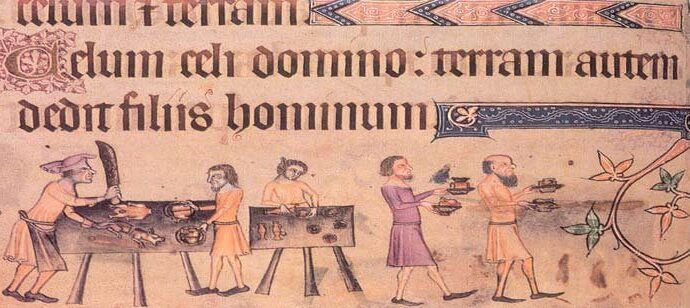
A Medieval Feast: The Mirror makes Medieval Meals
Editorial, Lifestyle, Uncategorized, Weekend March 29, 2021, Comments Off 436Let’s be honest: the economic future of college students is a very unsure and scary one. With the growing economic disparity in America, we might all end up becoming the modern equivalent of medieval peasants. So, to help us prepare for this possibility, a few of us at The Mirror decided to cook and eat peasant food.
In order to help us understand what peasants ate and why, we turned to history professor and Drury’s resident Medievalist, Dr. Shelley Wolbrink.
When asked about food and social class in the Middle Ages, she said, “Social class is important for understanding food in the Middle Ages. For the wealthy there was a form of entertainment involved whether it was layered foods in the shape of an exotic animals, the jesters, or the multiple courses. I like to compare this to a thanksgiving meal today, if your family still hauls out the good china and silver. This would be the place for meats, such as rabbits which became quite ubiquitous in the Middle Ages, and goat, fish, or in Italy—eel—with special chalices for salt; food served on trenchers, and no forks!”
However, the food for the average person would have been much simpler. “I like to compare a medieval diet to today’s Middle Eastern foods and Indian,” Wolbrink says. “There just isn’t a lot of cake, ice cream, chocolate. Honey is one sweetener. Another difference would be no tomatoes. Any kind of pasta or lasagna would be white. Personally as a vegetarian I eat a lot of carrots, spinach, kale, beans, peas, and lettuce already—and that’s not unlike a typical diet in the Middle ages.”
She also gives recommendations for where to find medieval-like food here in Springfield. “If you want to have some fun with going out and “eating medieval,” you could try a local Indian restaurant like Taj Mahal or Zayka for the similarities to stews, spices, cream sauces and use of rice. You could also visit a great bakery like Commercial street’s Artisan’s Oven and get a loaf of bread non-sliced; drop by Mama Jean’s for some Irish butter. Get a wood-fired pizza at Brunos (but no tomatoes). Visit the Lebanese Place on Commercial street for something like meat (lamb or chicken) and rice with some spices. London Calling at the mall is another good option—stew in a crust!”
Now that we had established a good background and gathered inspiration, it was time to get cooking.
Maclen
Of the many boons to come from majoring in history, the amount of delicious era-specific food I’ve eaten is high on the list. For my Ancient Civilizations class my sophomore year, I made Roman cheesecake (which really turned out to be more of a dense bread loaf than the dessert we think of today).
For today’s venture – a medieval feast – I didn’t adhere as tightly to century or geography as I probably should have. I blend recipes featuring Northern European butter and Italian olive oil ranging from the fifth to the 16th centuries. And, with all their spices, cheeses and sugars, these recipes wouldn’t have been too accessible to the peasants – this meal would have been a hit for land-owning vassals. Regardless, they were all tasty and easy to shop for in a 21st-century grocery store.
The star of the show was the twisted bread of milk and sugar. A 16th-century bread from Italy, this recipe was remarkably simple and easy to execute. I substituted the rosewater for an extra three tablespoons of normal water, and it worked just as well. Although the braids didn’t come out evenly, a rising time of an hour and a bake time of only 20 minutes cement it as a fun evening activity.
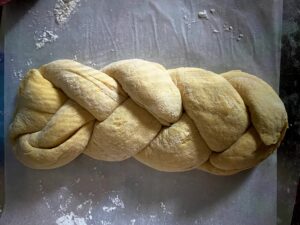
Twisted Bread – Photo by Maclen Johnson
My biggest mistake was using a sweet Moscato for the spinach greens. Parsley, sage and oregano were the spices included for the greens and the meatloaf, and they did their best in counteracting that fateful pour. The greens were edible but made better by mixing a forkful with the turnips.
An excellent comfort food, the roasted turnips demand an early start due to their lengthy cook time. After an hour in the oven, they get smothered with cheese and a spiced butter mixture before cooking another 35 minutes.
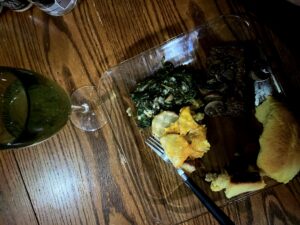
Feast of Kings – Photo by Maclen Johnson
Although Impossible Meat is a new invention, it did the trick in making the Roman meatloaf recipe vegetarian. The author even included a vegan version! Since I followed the recipes (mostly) directly, I didn’t add cornstarch or flour to thicken the gravy. I cooked the meatloaf in single-serve bread pans, but I’d suggest cutting even those in half with how dense these get.
Recipes from the Middle Ages aren’t intimidating, and they leave you grateful for how accessible the once-specialty items are today. With our spices and sugars, we’re eating like kings!
Julia
Barley Water
Ingredients:
- ¼ cup pearled barley
- 2 Tbsp sugar
- 2 cups boiling water
- Peel and juice from 1 lemon
Method:
Combine ingredients, cover until cool. Strain before serving.
My method for choosing recipes was to make one thing I was excited about and one I was suspicious of. Considering the ingredients of “barley water” shake out to be lemonade with a cereal grain, I had my doubts.

Preparing the barley water – Photo by Julia Chamberlain
The details were unclear as to whether I was to cook the barley before combining, but I figured the water would be hot enough for a while. I was correct in this assumption, as the cooling process took well over 15 minutes.
When it cooled, I strained it and decided to try the lemony barley by itself. I forgot about the sugar and was immediately intrigued by the taste: it wasn’t too sweet and it had a fairly neutral flavor, which gave me high hopes for the water.
The water was cloudy and a pleasant yellow, further confirming my theory that it was just lemonade with health benefits (barley is an incredible way to prevent kidney stones and lemon has high levels of Vitamin C.)
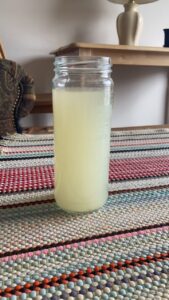
The Finish Product – Photo by Julia Chamberlain
Admittedly, there was nothing truly outstanding, good or bad, to say about this. It was the right amounts of sweet and tart, but with a subtle earthy aftertaste that didn’t distract from the drink, but definitely wasn’t unnoticed.
I don’t see myself making this again, but it’s not the worst treatment for kidney stones I could imagine.
⅗ stars.
Salat of Apples and Onions
Ingredients:
- 1 medium gala apple
- 1/2 medium sweet onion
- 1 Tbsp. olive oil
- 1 tsp. red wine vinegar
- 1/2 tsp. black pepper
Method: Chop apple and onion into similarly sized cubes. Mix oil, vinegar, pepper and combine.
I was very excited about this recipe, as I hoped it was popular because they had found a way to mask the aggressive taste of half of an onion, albeit a mellower and sweet onion, with about as much apple and a little dressing.
Preparation was easy enough. I was weary about cutting the onion into pieces as big as I had for the apple but hoped the red wine vinegar would neutralize it. Unfortunately, a single teaspoon is hardly enough to cover a whole apple, let alone all the layers of onion, so I ended up putting some more in, which had a nice effect.
At times, the onion was overpowering alone, but complemented the apple nicely. The apple by itself with the olive oil, red wine vinegar and pepper was absolutely delicious. Gala was a great choice for this recipe as it was subtle and sweet enough to balance everything out.
Of course, eating raw onions in that quantity and timespan doesn’t lead to your hands or breath smelling amazing, so I would recommend discretion with both the onion ratio and the time allotted to get yourself together again.
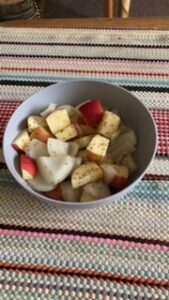
The Salat – Photo by Julia Chamberlain
I actually see myself making this dish again, but maybe playing around with the apple and olive oil ratio. This was a surprisingly modern dish for 17th century Italy, with an easy prep time and sufficient serving size.
⅘ stars
Sammie
I decided to make two dishes, one entree and one dessert. I made the entree, a charming little number called Drawen Benes, first. It consists of white beans, onion, vegetable broth, and salt. The recipe also calls for saffron, but saffron is too expensive for me so, like a good peasant, I just left it out and made do with what my meager wages could get me.
The recipe, in its original form, goes as follows: Take benes and seeþ hem and grynde hem in a morter and drawe hem up with gode broth an do Oynouns in the broth grete mynced an do þerto and colour it with Safroun and serve it forth. Luckily, the website I snagged this from deciphered this for me, so I got a much easier version to follow, which is good because I’m not sure I ever would have figured out what Oynouns were otherwise.
This dish was extremely easy to make. It only took about 15 minutes and I was able to make it all in just one pot. It turned out very gruel-like, which is what I expected. But honestly? It didn’t taste bad at all. It was bland, but in a kind of nice, nourishing way. I won’t say that I liked it, but I definitely wouldn’t mind eating it if my sweet peasant mother cooked it on the hearth and offered me some.

Drawen Benes – Photo by Sammie Ellis
I also had my roommate, the illustrious Emilee Harless, try it. After taking a bite, she closed her eyes and said ominously, “This takes me back.” She did not elaborate as to what time in her life she was referring to, and I was too scared to ask. Make of that what you will.
The second dish I made was a kind of dessert called Lenten Slices. It’s a sort of bread pudding that’s designed to be made and eaten during Lent since it doesn’t have any meat or animal products in it. It is made up of bread, almond milk, sugar, salt, dates, and raisins.
I’m going to be completely honest; this recipe was a bit of a disaster and for no other reason than my own incompetence. I had the milk, sugar, and salt boiling on the stove and I turned my back for a few seconds in order to open the package of dates. This was a mistake I immediately regretted. It all boiled over and became a burnt, sticky mess on my stove. It did smell like toasting marshmallows though, so that was a plus.
After I cleaned up the mess, the process went a lot more smoothly. I was able to add the other ingredients, throw it all in a tupperware and chill it. After being thoroughly chilled and allowed to coagulate, I slopped it on a plate.

Lenten Slices – Photo by Sammie Ellis
The name Lenten Slices is a little misleading considering it definitely didn’t slice well. It was more of a Lenten Mush than anything. However, it actually tasted pretty good. It was really sweet, and I wasn’t a huge fan of the mushy texture, but it wasn’t unbearable. I can imagine a peasant family bringing this to a medieval church potluck, if that’s something that happened back then. Emilee also tried this dish and said that it, “Tastes like liquified fig newtons.” I find this assessment to be an accurate one.
All of the recipes used in this article can be found here. Feel free to take a look and try your own medieval meal!
Article by Julia Chamberlain, Sammie Ellis and Maclen Johnson